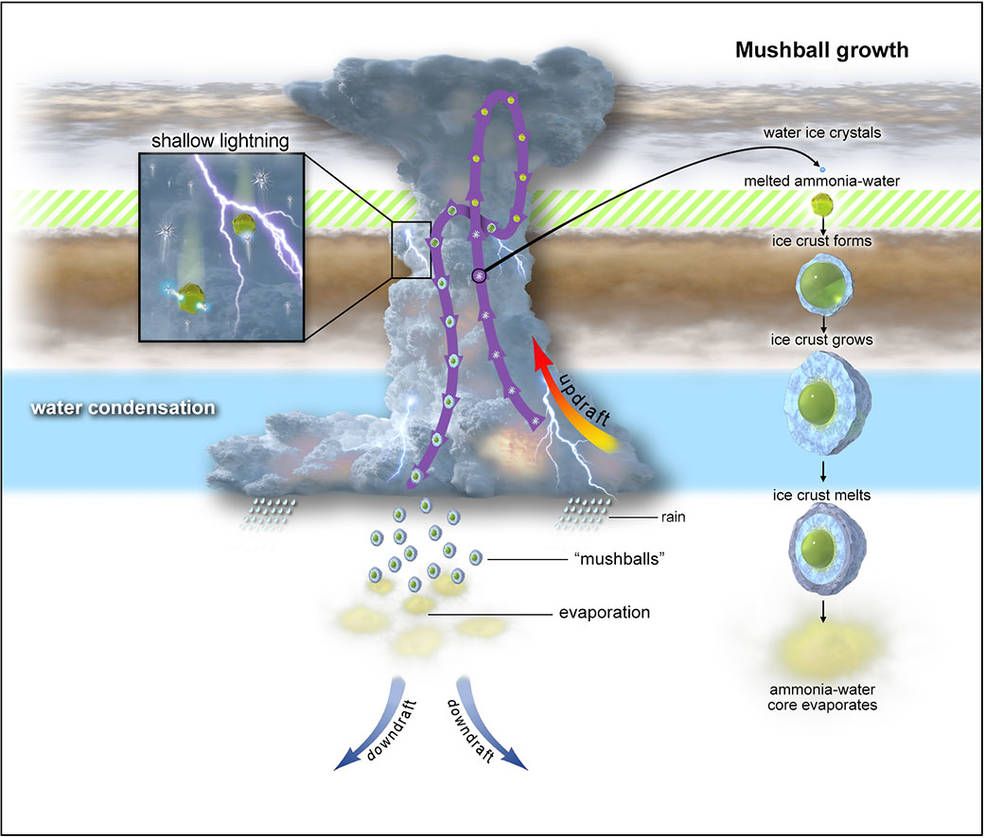The Forecast on Jupiter Is Cloudy With a Chance of ‘Mushballs’
New research describes the gas giant’s wild weather
/https://tf-cmsv2-smithsonianmag-media.s3.amazonaws.com/filer/34/81/3481d9b5-9b67-4dc0-aa7b-d7fe0d4d0b98/jupiter.jpg)
Jupiter, the largest planet in our solar system, is a roiling ball of gases and liquids constantly besieged by violent storms and hurricane-force winds—and that’s just the half of it, according to astronomers. In new research published this month, scientists working with NASA’s Juno spacecraft described two weather events on the gas giant: “shallow lightning,” which erupts in the planet’s upper atmosphere, and slushy, ammonia-rich hailstones known as “mushballs,” which might rain down from above.
The “shallow lightning” and “mushballs” were described this month in one paper in Nature and two papers in Journal of Geophysical Research: Planets, respectively, according to a NASA statement.
In Nature, researcher Heidi Becker with NASA’s Jet Propulsion Laboratory and her team report the observation of a smattering of lightning in Jupiter’s upper atmosphere. In February 2018, Becker and her team decided to take Juno’s navigation camera—which typically looks at nearby stars—and take a peek at the Jupiter’s dark nightside.
There, they made an exciting discovery: “To the team’s surprise, the clouds crackled with electricity,” reports Lisa Grossman for Science News.
“Juno’s close flybys of the cloud tops allowed us to see something surprising—smaller, shallower flashes—originating at much higher altitudes in Jupiter's atmosphere than previously assumed possible,” Becker describes in a NASA statement.
On Earth, lightning flashes only occur when water exists in all its forms: frozen, liquid and gas. These flashes were occurring nearly 16 miles above Jupiter’s water clouds, where the temperature is much too cold for liquid water to exist, per the NASA statement.
The team hypothesizes that ammonia in Jupiter’s atmosphere is responsible for the lightning, as Matthew Hart reports for Nerdist. “At these altitudes, the ammonia acts like an antifreeze, lowering the melting point of water ice and allowing the formation of a cloud with ammonia-water liquid,” says Becker in the statement. “In this new state, falling droplets of ammonia-water liquid can collide with the upgoing water-ice crystals and electrify the clouds. This was a big surprise, as ammonia-water clouds do not exist on Earth.”

In two other papers, Tristan Guillot with the Université Côte d’Azur, Becker and others theorize that some of Jupiter’s atmospheric ammonia reacts with water ice crystals to form balls of water-ammonia slush covered in ice. These softball-sized hailstones are pushed up into Jupiter’s atmosphere on updrafts, and then become too heavy and fall down to deep levels in Jupiter’s atmosphere, warming up as they fall until they evaporate. As Passant Rabie reports for Inverse, this theory could help explain the presence of ammonia and water in the lower part of the planet’s atmosphere.
The swirling atmosphere we see on Jupiter is home to violent storms. @NASASolarSystem’s Juno mission discovered new evidence pointing to shallow lightning & slushy ammonia-rich hailstones known as mushballs. #ScienceInSeconds on Jupiter's exotic weather: https://t.co/2LSs19l0ki pic.twitter.com/IXjSCyjNDF
— Thomas Zurbuchen (@Dr_ThomasZ) August 5, 2020
Through analyzing Jupiter’s meteorology, scientists aim to learn more about how the weather dynamics on other planets, including planets outside our solar system. As Becker tells Science News, similar “shallow” lightning storms might take place on exoplanets. “Every time you have a new realization, it feeds into new theories that will be developed not only for our solar system but for other solar systems,” says Becker.
The research also demonstrates the critical role that ammonia plays in Jupiter’s weather. “On Earth, [the weather events are] all driven by water. But on Jupiter, it’s a little bit different. Ammonia starts playing a really important role,” says Scott Bolton, the principal investigator on Juno, in a video interview about the findings.
/https://tf-cmsv2-smithsonianmag-media.s3.amazonaws.com/accounts/headshot/nora.png)


/https://tf-cmsv2-smithsonianmag-media.s3.amazonaws.com/accounts/headshot/nora.png)